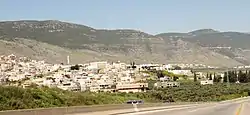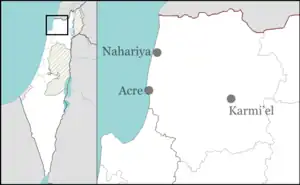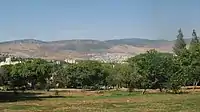Nahf
| |
|---|---|
| Hebrew transcription(s) | |
| • ISO 259 | Náḥep |
| • Also spelled | Nahef (official) Naḥf (unofficial) |
 | |
 Nahf | |
| Coordinates: 32°55′54″N 35°19′11″E / 32.93167°N 35.31972°E | |
| Grid position | 179/260 PAL |
| District | Northern |
| Area | |
| • Total | 6,077 dunams (6.077 km2 or 2.346 sq mi) |
| Population (2021)[1] | |
| • Total | 13,558 |
| • Density | 2,200/km2 (5,800/sq mi) |
Nahf (Arabic: نحف, Naḥf or Nahef; Hebrew: נַחְף)[2] is an Arab town in the Northern District of Israel. It is located in between the lower and upper Galilee, about 23 kilometres (14 mi) east of Acre. In 2021 it had a population of 13,558.[1] Archaeologists believe that the area was an important center for viticulture in the Hellenistic period and possibly the Early Bronze Age IB period (ca. 3100 BC).[3]
History
Remains have been found from Early Bronze IB, EB II, Middle Bronze Age II and Iron Age II,[4][5] as well as coins from the Ptolemaic dynasty and Antiochus III.[6] Tombs from the 2nd to the 4th centuries have been found.[7] Nahf contains Persian, Hellenistic and Roman remains.[4][6][5]
From archaeological finds, it is assumed that blown glass vessels were produced in the village during the Byzantine era. A bath, containing a hypocaust from the same period has also been excavated. Dating from the late Byzantine era, it was in continuous use in the early Umayyad era.[8]
In the Crusader era it was known as "Nef."[9][10] In 1249 John Aleman transferred land, including the casalia of Beit Jann, Sajur, Majd al-Krum and Nahf to the Teutonic Knights.[11][12]
Remains, including potsherds of bowls, plates and jars, all from Mamluk era, (fourteenth–fifteenth centuries CE), have been found in archaeological excavations.[13][5]
Ottoman era
In 1517, the village was incorporated into the Ottoman Empire with the rest of Palestine, and in 1596, Nahaf appeared in Ottoman tax registers as being in nahiya (subdistrict) of Akka, part of Sanjak Safad. It had a population of 108 households and 9 bachelors, all Muslims. The villagers paid a fixed tax rate of 25% on wheat, barley, summer crops, fruit trees, goats and/or beehives, in addition to occasional revenues; a total of 6,629 akçe.[14]
A map from 1799 by Pierre Jacotin showed the place, named as "Nafeh".[15] When Victor Guérin visited Nahf in 1875, he described the village as containing 400 Muslims and some Greek Orthodox families,[16] while in 1881 Nahf was described as being built of stone, containing 200 Muslims, with olives and arable land.[17]
A population list from about 1887 showed that Nahf had about 475 inhabitants; all Muslims.[18]
British Mandate era
In the 1922 census of Palestine conducted by the British Mandate authorities, Nahf had a population of 818, 2 Jews, 6 Christians and 810 Muslims.[19] where all the Christians were Orthodox.[20] At the time of the 1931 census the population had increased to 994, all Muslims, in 194 houses.[21]
In the 1945 statistics the population of Nahf was 1,320, all Muslims,[22] who owned 15,745 dunams of land according to an official land and population survey.[23] 1,088 dunams were plantations and irrigable land, 4,571 used for cereals,[22][24] while 44 dunams were built-up (urban) land.[22][25]
State of Israel

Nahf was captured by Israel on 18 July 1948 during Operation Dekel led by the Sheva (Seventh) Brigade. Its defenders included the town's local militia as well as Arab Liberation Army volunteers. The town was left intact and most residents did not flee their homes. There was a massacre carried out by the IDF Moshe Carmel's troops after the fighting was over.[26] The population remained under Martial Law until 1966.
In and around Nahf, there are a number of archaeological remains dating from the Middle Ages, including mosaics and a cemetery. In a nearby location lies the shrines of Muslim leaders Sheik Muhammad Rabiah and Sheik Mahmud who fought against the Crusaders. The Auba cave, which dates from the time of the Assyrians, is also located here.[27]
Notable structures
The largest medieval structure in the village is a roughly 10 meter long wall, made of large drafted blocks with a rubble core, which may be of Crusader origin.[9][28]
The Maqam (shrine) of Shaykh Rabi is located on a steep hill above the village, surrounded by a cemetery. It is a domed rectangular building, with an entrance from the east. A deep mihrab ("Islamic prayer niche") is located inside, in the middle of the south side. By the north wall is the elongated cenotaph of Shaykh Rabi.[28]
See also
References
- 1 2 "Regional Statistics". Israel Central Bureau of Statistics. Retrieved 22 February 2023.
- ↑ Palmer, 1881, pp. 64, 92
- ↑ Koh, A. J.; Yasur-Landau, A.; Cline, E. H. (2014). "Characterizing a Middle Bronze Palatial Wine Cellar from Tel Kabri, Israel". PLOS ONE. 9 (8): e106406. Bibcode:2014PLoSO...9j6406K. doi:10.1371/journal.pone.0106406. PMC 4146609. PMID 25162228.
- 1 2 Smithline, 2005, Nahf
- 1 2 3 Cinamon, 2012, Nahf
- 1 2 Tepper, 2007, Nahf (East)
- ↑ Dauphin, 1998, p. 640
- ↑ Abu Raya, 2013, Nahf
- 1 2 Pringle, 1997, p. 114
- ↑ Conder and Kitchener, 1881, SWP I, p. 255. Cited in Petersen, 2001, p. 239
- ↑ Strehlke, 1869, pp. 78-79, No. 100; cited in Röhricht, 1893, RHH, p. 308, No. 1175; cited in Frankel, 1988, pp. 254, 265
- ↑ Conder and Kitchener, 1881, SWP I, p. 208
- ↑ Lerer, 2009, Nahf
- ↑ Hütteroth and Abdulfattah, 1977, p. 192
- ↑ Karmon, 1960, p. 166, Cited in Petersen, 2001, p. 239
- ↑ Guérin, 1880, pp. 451 - 452 Cited partially in Conder and Kitchener, 1881, SWP I, p. 255. Translation in Petersen, 2001, p. 239
- ↑ Conder and Kitchener, 1881, SWP I, p. 203
- ↑ Schumacher, 1888, p. 174
- ↑ Barron, 1923, Table XI, Sub-district of Acre, p. 36
- ↑ Barron, 1923, Table XVI, p. 50
- ↑ Mills, 1932, p. 102
- 1 2 3 Government of Palestine, Department of Statistics, 1945, p. 4
- ↑ Government of Palestine, Department of Statistics. Village Statistics, April, 1945. Quoted in Hadawi, 1970, p. 41
- ↑ Government of Palestine, Department of Statistics. Village Statistics, April, 1945. Quoted in Hadawi, 1970, p. 81
- ↑ Government of Palestine, Department of Statistics. Village Statistics, April, 1945. Quoted in Hadawi, 1970, p. 131
- ↑ Rogan and Shlaim, 2001, pp. 54-55
- ↑ Welcome To Nahf
- 1 2 Petersen, 2001, p. 239
Bibliography
- Abu Raya, Rafeh (2013-06-09). "Nahf" (125). Hadashot Arkheologiyot – Excavations and Surveys in Israel.
{{cite journal}}: Cite journal requires|journal=(help) - Barron, J.B., ed. (1923). Palestine: Report and General Abstracts of the Census of 1922. Government of Palestine.
- Cinamon, Gilad (2012-09-19). "Nahf" (124). Hadashot Arkheologiyot – Excavations and Surveys in Israel.
{{cite journal}}: Cite journal requires|journal=(help) - Conder, C.R.; Kitchener, H.H. (1881). The Survey of Western Palestine: Memoirs of the Topography, Orography, Hydrography, and Archaeology. Vol. 1. London: Committee of the Palestine Exploration Fund.
- Dauphin, C. (1998). La Palestine byzantine, Peuplement et Populations. BAR International Series 726 (in French). Vol. III : Catalogue. Oxford: Archeopress. ISBN 0-860549-05-4.
- Frankel, Rafael (1988). "Topographical notes on the territory of Acre in the Crusader period". Israel Exploration Journal. 38 (4): 249–272.
- Government of Palestine, Department of Statistics (1945). Village Statistics, April, 1945.
- Guérin, V. (1880). Description Géographique Historique et Archéologique de la Palestine (in French). Vol. 3: Galilee, pt. 1. Paris: L'Imprimerie Nationale.
- Hadawi, S. (1970). Village Statistics of 1945: A Classification of Land and Area ownership in Palestine. Palestine Liberation Organization Research Center.
- Hütteroth, Wolf-Dieter; Abdulfattah, Kamal (1977). Historical Geography of Palestine, Transjordan and Southern Syria in the Late 16th Century. Erlanger Geographische Arbeiten, Sonderband 5. Erlangen, Germany: Vorstand der Fränkischen Geographischen Gesellschaft. ISBN 3-920405-41-2.
- Karmon, Y. (1960). "An Analysis of Jacotin's Map of Palestine" (PDF). Israel Exploration Journal. 10 (3, 4): 155–173, 244–253. Cited in Petersen, 2001
- Lerer, Yoav (2009-06-08). "Nahf" (121). Hadashot Arkheologiyot – Excavations and Surveys in Israel.
{{cite journal}}: Cite journal requires|journal=(help) - Mills, E., ed. (1932). Census of Palestine 1931. Population of Villages, Towns and Administrative Areas. Jerusalem: Government of Palestine.
- Palmer, E.H. (1881). The Survey of Western Palestine: Arabic and English Name Lists Collected During the Survey by Lieutenants Conder and Kitchener, R. E. Transliterated and Explained by E.H. Palmer. Committee of the Palestine Exploration Fund.
- Petersen, Andrew (2001). A Gazetteer of Buildings in Muslim Palestine (British Academy Monographs in Archaeology). Vol. I. Oxford University Press. ISBN 978-0-19-727011-0.
- Pringle, D. (1997). Secular buildings in the Crusader Kingdom of Jerusalem: an archaeological Gazetter. Cambridge University Press. ISBN 0521-46010-7.
- Rogan, E.; Shlaim, A. (2001). The War for Palestine: Rewriting the History of 1948. Cambridge University Press. ISBN 0-521-79476-5.
- Röhricht, R. (1893). (RRH) Regesta regni Hierosolymitani (MXCVII-MCCXCI) (in Latin). Berlin: Libraria Academica Wageriana.
- Schumacher, G. (1888). "Population list of the Liwa of Akka". Quarterly Statement - Palestine Exploration Fund. 20: 169–191.
- Strehlke, Ernst, ed. (1869). Tabulae Ordinis Theutonici ex tabularii regii Berolinensis codice potissimum. Berlin: Weidmanns.
- Smithline, Howard (2005-03-30). "Nahf" (117). Hadashot Arkheologiyot – Excavations and Surveys in Israel.
{{cite journal}}: Cite journal requires|journal=(help) - Tepper, Y. (2007-08-16). "Nahf (East) Final Report" (119). Hadashot Arkheologiyot – Excavations and Surveys in Israel. Archived from the original on 2012-05-15. Retrieved 2010-05-09.
{{cite journal}}: Cite journal requires|journal=(help)
External links
- Official website (in Arabic and Hebrew)
- Welcome To Nahf
- Survey of Western Palestine, Map 4: IAA, Wikimedia commons
.svg.png.webp)